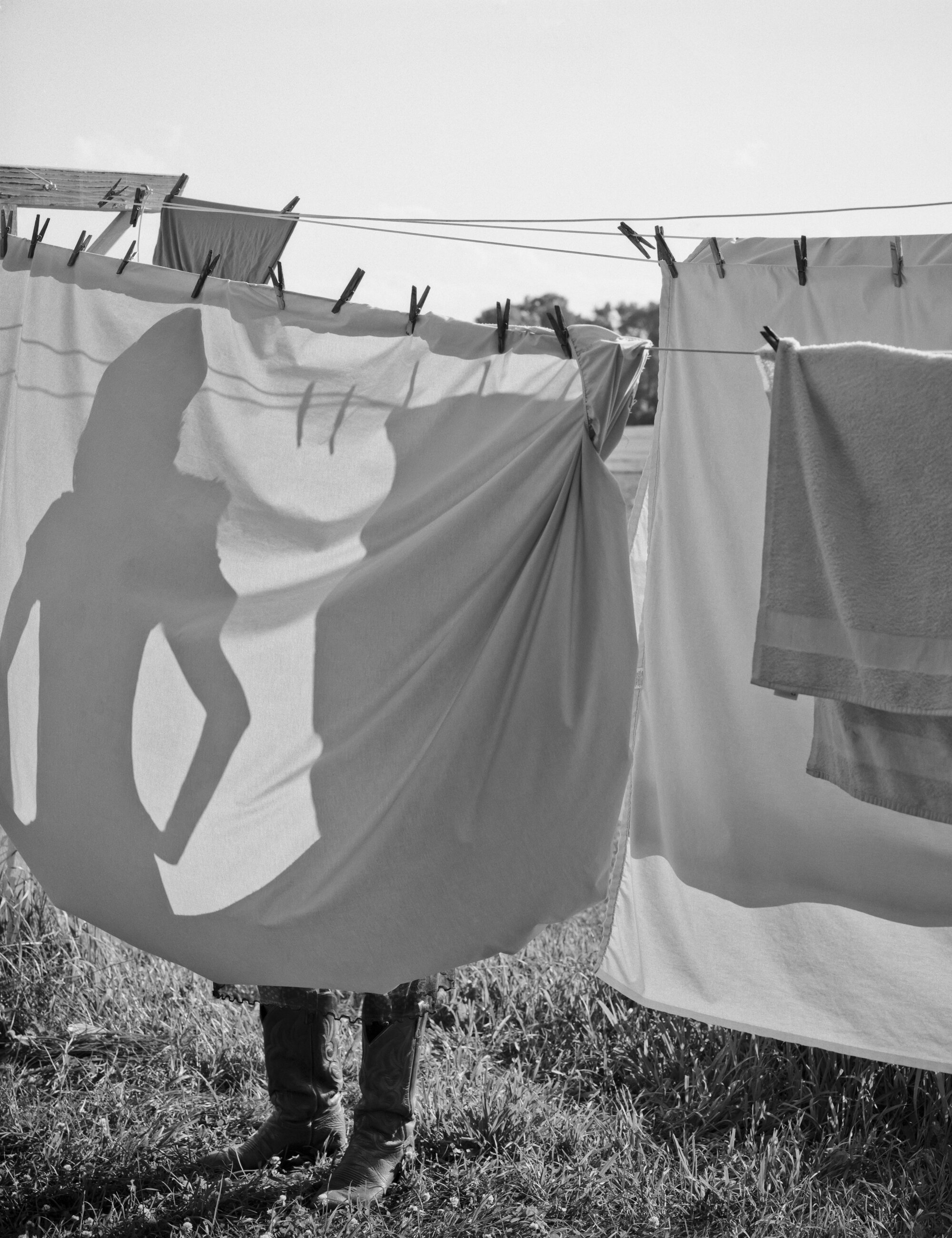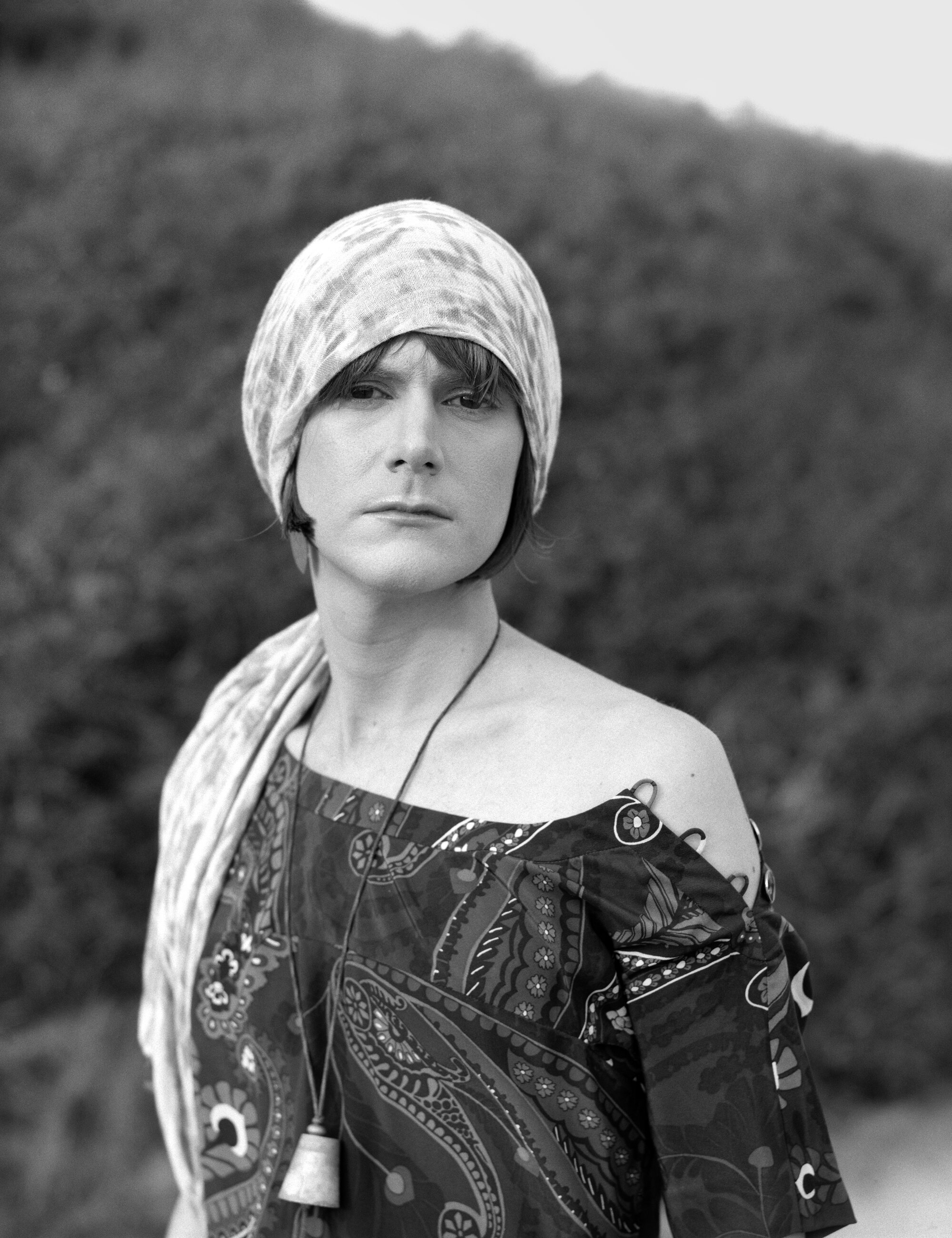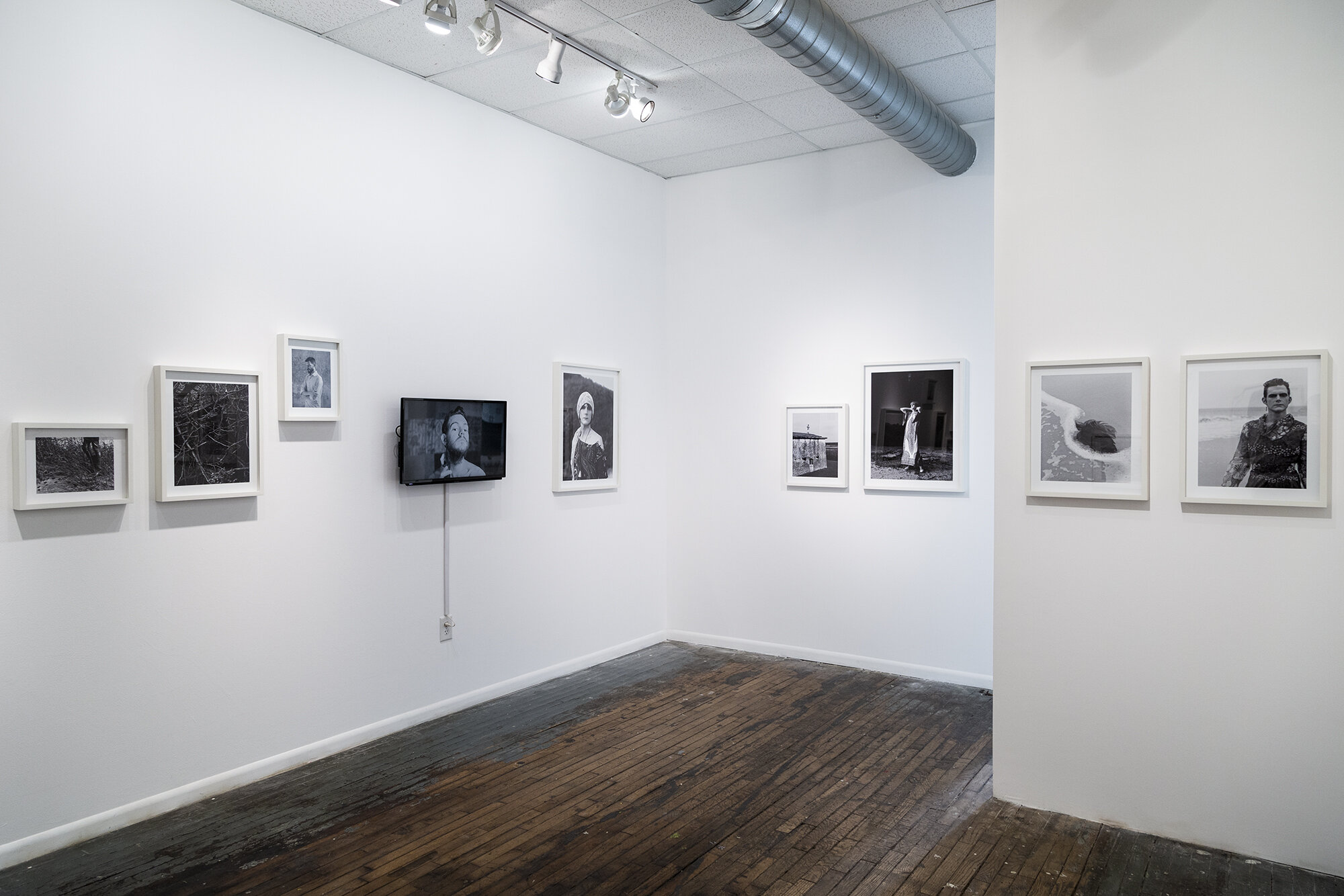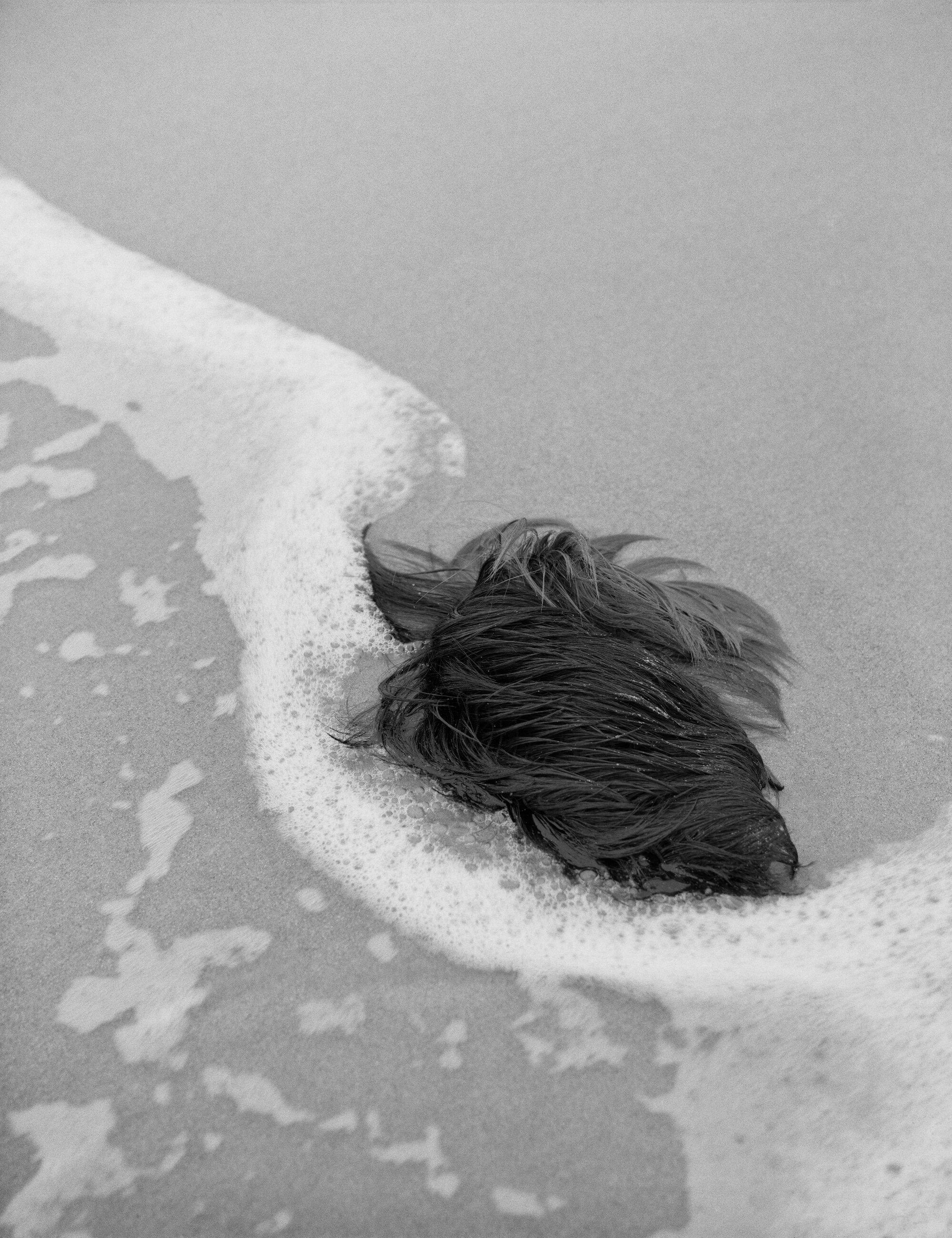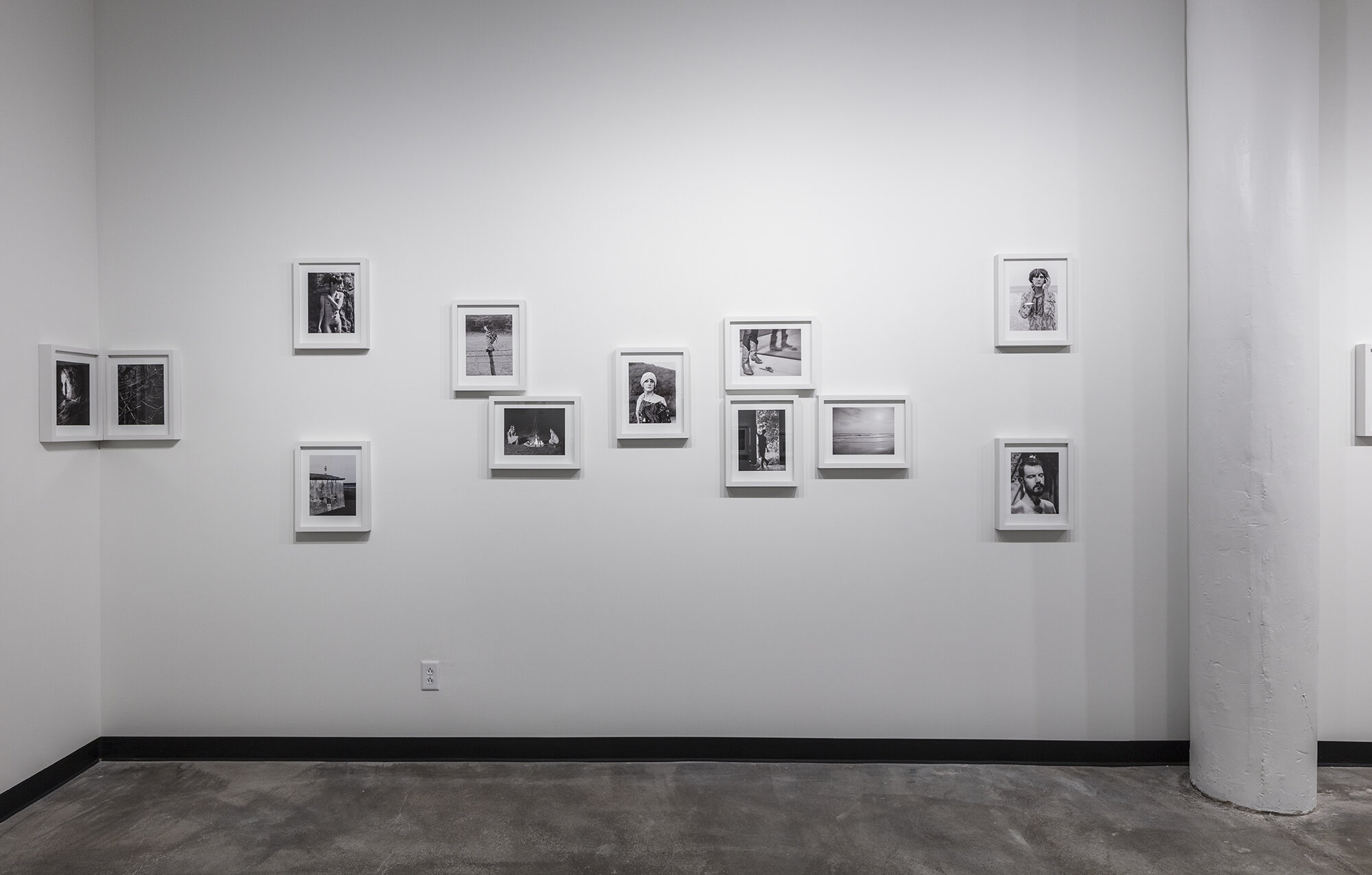Wig Heavier Than a Boot
Wig Heavier Than a Boot brings together photography and video by David Johnson and poetry by Philip Matthews. Revealing Petal—a persona as whom Philip manifests to write, whom David photographs—the project crosses art-making rituals with isolated performances in domestic spaces and pastoral landscapes. Taken together, the images and poems reveal surprising relationships between character, observer, and author. The photographs provide one record of Petal and Philip’s personalities, blurring art-historical feminine / masculine postures and gestures. The poems provide another which elaborates upon the lived experience of performing or, sometimes, obscuring or protecting the self from being seen. Observing and being become equal contributions to the work: a continuous exchange between photographer and two subjects in one body, that dwells in complications of power and gender expression through the history of photography.
The practice is one in slowness: preparing a large-format photograph and waiting for Petal to arrive, alternately present within Philip or in elements of the landscape. In this process, David and Philip continually break open and leverage their own biases and desires to create an authentic body of work in collaboration with each other and with Petal. David scouts locations that correlate to the world of the poems—muck, thicket, water’s edge—while Philip uses elements of drag to become Petal for the camera (and mirror), taking notes that give way to poetry. Subverting the ekphrastic literary tradition in which a poet responds to a visual artwork, Philip’s poems do not correlate one-to-one to Johnson’s photographs nor vice-versa. Both forms are made in the present, and have arcs that can be read independently though they are made fuller by the presence of the other.
Both photographs and poems balance narrative with fragmentation and invite multiple interpretations. The photographs capture the distinct or simultaneous presences of two subjects while the poems hybridize their perspectives, enacting a relationship that is surreal, empowering, and unbearable, as the project title suggests. What is constant is a sense of a person wanting to belong to the place that hosts them (farmland in rural Wisconsin, the coast of North Carolina, an art museum in St. Louis, a small church), even or especially when the social norms of that place are felt to ostracize queer people. It is important to acknowledge that while David is a straight man and Philip is queer, both artists feel a fuller sense of self from having known Petal. Three players collaborate in this work, drawing upon their express differences to mutually learn from one another.
Order Wig Heavier Than a Boot Book From Kris Graves Projects
Exhibited at:
The Griffin Museum of Photography, Winchester, MA*
Brooks Stevens Gallery, Milwaukee Institute of Art & Design, Milwaukee, WI*
Fort Worth Contemporary Arts as part of 150 years/150 Artist, Texas Christian University, Fort Worth, TX
Blue Star Contemporary as part of The Sitter, San Antonio, TX
Moreau Art Galleries at Saint Mary’s College, Notre Dame, IN*
FotoFest 2020 Biennial as part of Ten x Ten, Houston, TX
Filter Space, Chicago, IL*
Colorado Photographic Arts Center as part of The Space Between, Denver, CO
The High Low, St. Louis, MO*
KGP | LIC, Long Island City, NY*
The Center for Fine Art Photography as part of Center Forward, Fort Collins, CO
Plug Projects, Kansas City, MO*
the beverly, St. Louis, MO*
*denotes Solo Exhibition
Activate the Muse, 2019
Video By David Johnson
Written by Philip Matthews,
Performed by Philip Matthews and Petal
Exhibited at:
Blue Star Contemporary as part of The Sitter, San Antonio, TX
Moreau Art Galleries at Saint Mary’s College, Notre Dame, IN*
Colorado Photographic Arts Center as part of The Space Between, Denver, CO
The High Low, St. Louis, MO*
Crown and Crowning, 2016
Video By David Johnson
Written by Philip Matthews,
Performed by Philip Matthews
Exhibited at:
Moreau Art Galleries at Saint Mary’s College, Notre Dame, IN*
Colorado Arts Center as part of The Space Between, Denver, CO
The High Low, St. Louis, MO*
Plug Projects, Kansas City, MO*
the beverly, St. Louis, MO*
*denotes Solo Exhibition
DAVID JOHNSON AND PHILIP MATTHEWS’ WIG HEAVIER THAN BOOT
on the occasion of the exhibition Ten by Ten
as part of the 2020 FotoFest Biennial, Houston, Texas
By Allie Haeusslein
Associate Director of Pier 24 Photography in San Francisco
Photographer David Johnson was first introduced to Petal, a female persona performed by the poet Philip Matthews, at a residency that both artists attended. The duality fascinated Johnson. “My interest in seeing Phil develop and Petal come through lies in the tension between author and character, and how character becomes the author,” he says. “I was intrigued by [Matthews’s] writing process, and what the marriage between word and photograph could be.” From that chance encounter, a multiyear collaboration was born. Their resulting project, Wig Heavier Than a Boot (2019), explores Petal’s use of image and word, recontextualizing conventional ideas and spaces in both photography and poetry—particularly with respect to gender and identity—through a more nuanced, flexible, and inclusive lens.
From 2014 to 2018, Johnson used his 4x5 camera to photograph Petal in a variety of locations, ranging from Wisconsin to North Carolina. During these shoots, Matthews made notes that helped him write some of the poems—through the voice of Petal—that exist alongside the project’s photographs. Wig Heavier Than a Boot, however, is not an ekphrastic project; a poem does not illustrate a particular photograph. The artists explain, “Both forms are initiated in the shared experience of the photo shoot, developed by poet and photographer respectively after the shoot, with the final forms brought together in the editing phase.” Though neither form is illustrative, these two mediums are undeniably symbiotic; shared gestures, tones, materials, and landscapes appear in both photographs and poems, blending together to create something greater than the constituent parts.
The collaborators selected locations based on available opportunities (being at residencies, for instance), but also on the evolving needs of the project; in many cases, they ended up in places where Matthews did not feel especially comfortable growing up, including his home state of North Carolina. Though these landscapes span six different states, they share a timeless, rugged, and often pastoral quality, sidestepping vestiges of contemporary urban life in favor of more timeless, quintessential Midwestern and Southern environs. Petal appears in the woods, on a farm, among the brambles, perched atop archaic brick buildings, entering a dark cave, encircled in bright light almost like a religious icon. In several portraits, Matthews appears as himself. And in others still, some combination of persona and poet is represented. For Johnson, pictures like F. Holland Day’s The Vision (Orpheus Scene)(1907) and Anne Brigman’s Soul of the Blasted Pine(1907) served as examples he sought to contemporize in Wig Heavier Than a Boot. To those, I would add aesthetic echoes of Emmet Gowin, Sally Mann, even Ralph Eugene Meatyard, all artists who photographed in similar rural landscapes, but whose primary subjects were their families. Though they share no familial or romantic relationship, Johnson and Matthews have managed to create portraits of Petal that evoke intimacy and tenderness. In those photographs where Petal’s figure does not appear, she transcends the corporeal, her presence lingering within landscapes and still lifes. Viewers are invited to wonder how these landscapes and objects carry traces of Petal’s—and even Matthews’s and Johnson’s—experience, particularly regarding notions of collaboration, home, identity, and gender.
Petal’s performance for the camera and voice in the project’s poetry incorporates another facet into the oscillating dynamic between author, character, and collaborator: a queer subtext. As Matthews notes, “There’s something transformative and powerful, but also terrifying, burdensome, about becoming Petal. To my mind, there’s something queer in this: this idea that performing alternative parts of the psyche, especially those that have been repressed (closeted) over time, unlocks great power, but also great discomfort. Coming face to face with the parts of yourself you’ve spent so much of your time trying to hide.” Portraits of Petal call to mind Marcel Duchamp’s female alter ego Rose Sélavy, Claude Cahun’s gender-bending self-portraits, and more contemporary projects like Sam Contis’s Deep Springs (2017), which suggests a more fluid continuum from feminine to masculine. Matthews also sees Petal’s introduction to these landscapes as imperative to helping reshape perceptions of Southern poetry. “Someone recently asked me whether I call myself a Southern poet,” he recalls. “I do. I think it’s important to challenge outdated notions of who and what kinds of poetry get included when we call that category to mind. For me, positioning Petal in these spaces is part of that work.”
Photographer Duane Michals, known for combining image and text in much of his work, devised the concept of the “prose portrait.” “A prose portrait doesn’t necessarily show you what someone looks like; it’s not a line-for-line reproduction of a face,” he explains. “A prose portrait tells you what the nature of the person is about….When I photographed [Andy] Warhol, the portrait was in the character, the mystery—if there is one—of Warhol. You can’t capture someone, per se. How could you? The subject probably doesn’t even know who he (or she) is. So, for me, a prose portrait is about a person, rather than of a person.”[1]I like to think that this term—an amalgam of language and photography that embraces the lyrical rather than the literal—speaks meaningfully to the photographs and even the poems included in Wig Heavier Than a Boot.
[1]Duane Michals quoted in Siobhan Bohnacker, “The Last Sentimentalist: A Q&A with Duane Michals,” The New Yorker.Available at https://projects.newyorker.com/portfolio/michals-empty-ny/


